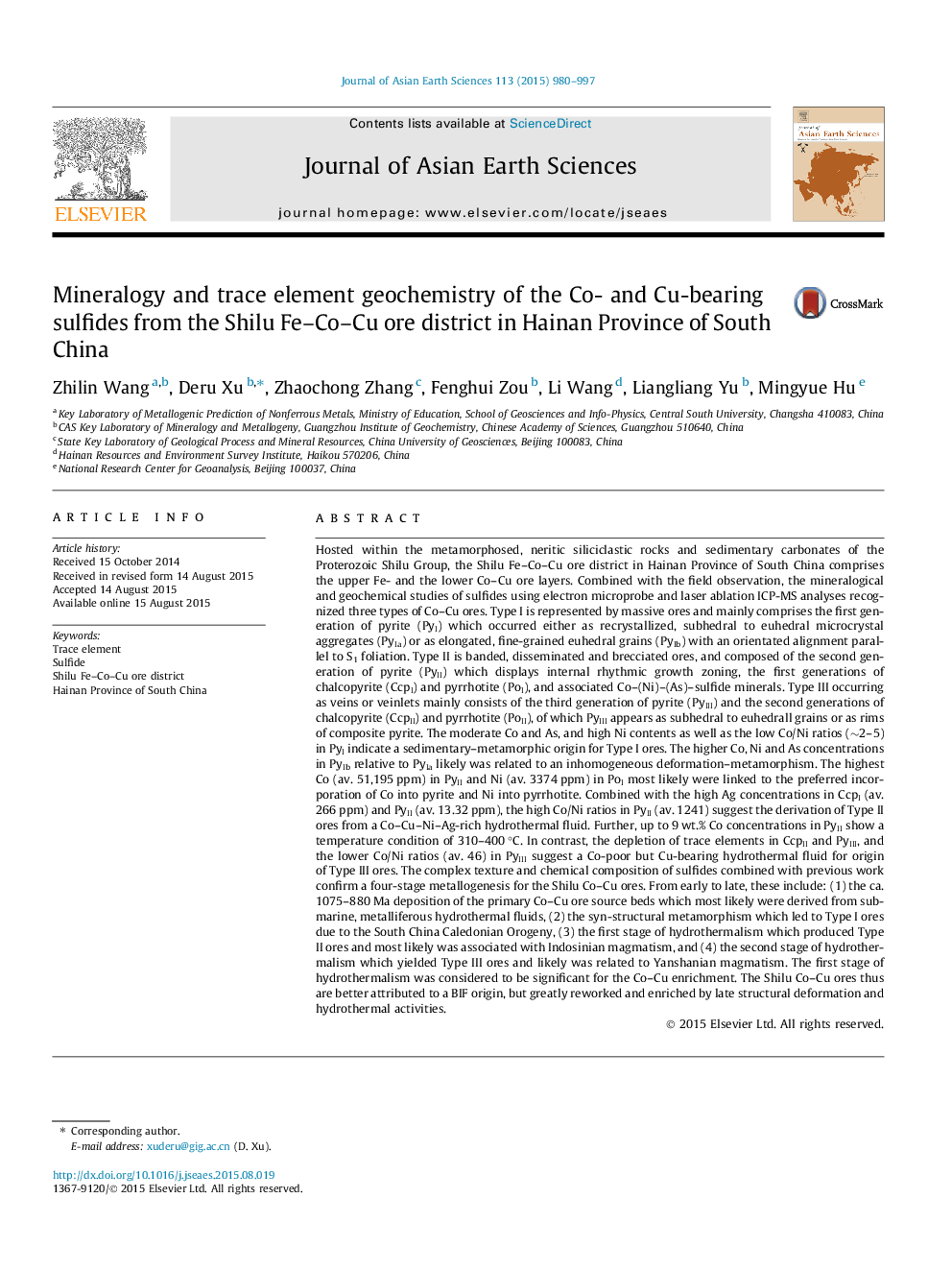| Article ID | Journal | Published Year | Pages | File Type |
|---|---|---|---|---|
| 4730274 | Journal of Asian Earth Sciences | 2015 | 18 Pages |
•Three generations of Co- or Cu-bearing sulfides have distinct textures and compositions.•At least three stages of Co–Cu metallogenesis were identified.•Early stage of syn-tectonic metamorphism led to initial enrichment of Co and Cu.•First stage of hydrothermal mineralization significantly upgraded Co–Cu ores.•Shilu Co–Cu ores were of BIF origin but largely reworked and refined.
Hosted within the metamorphosed, neritic siliciclastic rocks and sedimentary carbonates of the Proterozoic Shilu Group, the Shilu Fe–Co–Cu ore district in Hainan Province of South China comprises the upper Fe- and the lower Co–Cu ore layers. Combined with the field observation, the mineralogical and geochemical studies of sulfides using electron microprobe and laser ablation ICP-MS analyses recognized three types of Co–Cu ores. Type I is represented by massive ores and mainly comprises the first generation of pyrite (PyI) which occurred either as recrystallized, subhedral to euhedral microcrystal aggregates (PyIa) or as elongated, fine-grained euhedral grains (PyIb) with an orientated alignment parallel to S1 foliation. Type II is banded, disseminated and brecciated ores, and composed of the second generation of pyrite (PyII) which displays internal rhythmic growth zoning, the first generations of chalcopyrite (CcpI) and pyrrhotite (PoI), and associated Co–(Ni)–(As)–sulfide minerals. Type III occurring as veins or veinlets mainly consists of the third generation of pyrite (PyIII) and the second generations of chalcopyrite (CcpII) and pyrrhotite (PoII), of which PyIII appears as subhedral to euhedrall grains or as rims of composite pyrite. The moderate Co and As, and high Ni contents as well as the low Co/Ni ratios (∼2–5) in PyI indicate a sedimentary–metamorphic origin for Type I ores. The higher Co, Ni and As concentrations in PyIb relative to PyIa likely was related to an inhomogeneous deformation–metamorphism. The highest Co (av. 51,195 ppm) in PyII and Ni (av. 3374 ppm) in PoI most likely were linked to the preferred incorporation of Co into pyrite and Ni into pyrrhotite. Combined with the high Ag concentrations in CcpI (av. 266 ppm) and PyII (av. 13.32 ppm), the high Co/Ni ratios in PyII (av. 1241) suggest the derivation of Type II ores from a Co–Cu–Ni–Ag-rich hydrothermal fluid. Further, up to 9 wt.% Co concentrations in PyII show a temperature condition of 310–400 °C. In contrast, the depletion of trace elements in CcpII and PyIII, and the lower Co/Ni ratios (av. 46) in PyIII suggest a Co-poor but Cu-bearing hydrothermal fluid for origin of Type III ores. The complex texture and chemical composition of sulfides combined with previous work confirm a four-stage metallogenesis for the Shilu Co–Cu ores. From early to late, these include: (1) the ca. 1075–880 Ma deposition of the primary Co–Cu ore source beds which most likely were derived from submarine, metalliferous hydrothermal fluids, (2) the syn-structural metamorphism which led to Type I ores due to the South China Caledonian Orogeny, (3) the first stage of hydrothermalism which produced Type II ores and most likely was associated with Indosinian magmatism, and (4) the second stage of hydrothermalism which yielded Type III ores and likely was related to Yanshanian magmatism. The first stage of hydrothermalism was considered to be significant for the Co–Cu enrichment. The Shilu Co–Cu ores thus are better attributed to a BIF origin, but greatly reworked and enriched by late structural deformation and hydrothermal activities.
